Report on Corporate and Financial Accounting of ASX Listed Companies
VerifiedAdded on 2021/02/20
|13
|3199
|61
Report
AI Summary
This report provides an in-depth analysis of corporate and financial accounting, concentrating on the owner's equity and liabilities sections of the balance sheets of CSL Limited and Woodside Petroleum, both listed on the ASX. The report examines the specific items included in these sections, such as common stock, retained earnings, and various liabilities, and explains the movements in their values over a three-year period (2016-2018). Furthermore, the report details the advantages and disadvantages of the sources of funds used by both companies. The report also includes a critical examination of the concepts of small, large proprietary companies and reporting entities. The analysis offers insights into the financial performance and strategies of the selected companies, providing a comprehensive overview of their accounting practices.
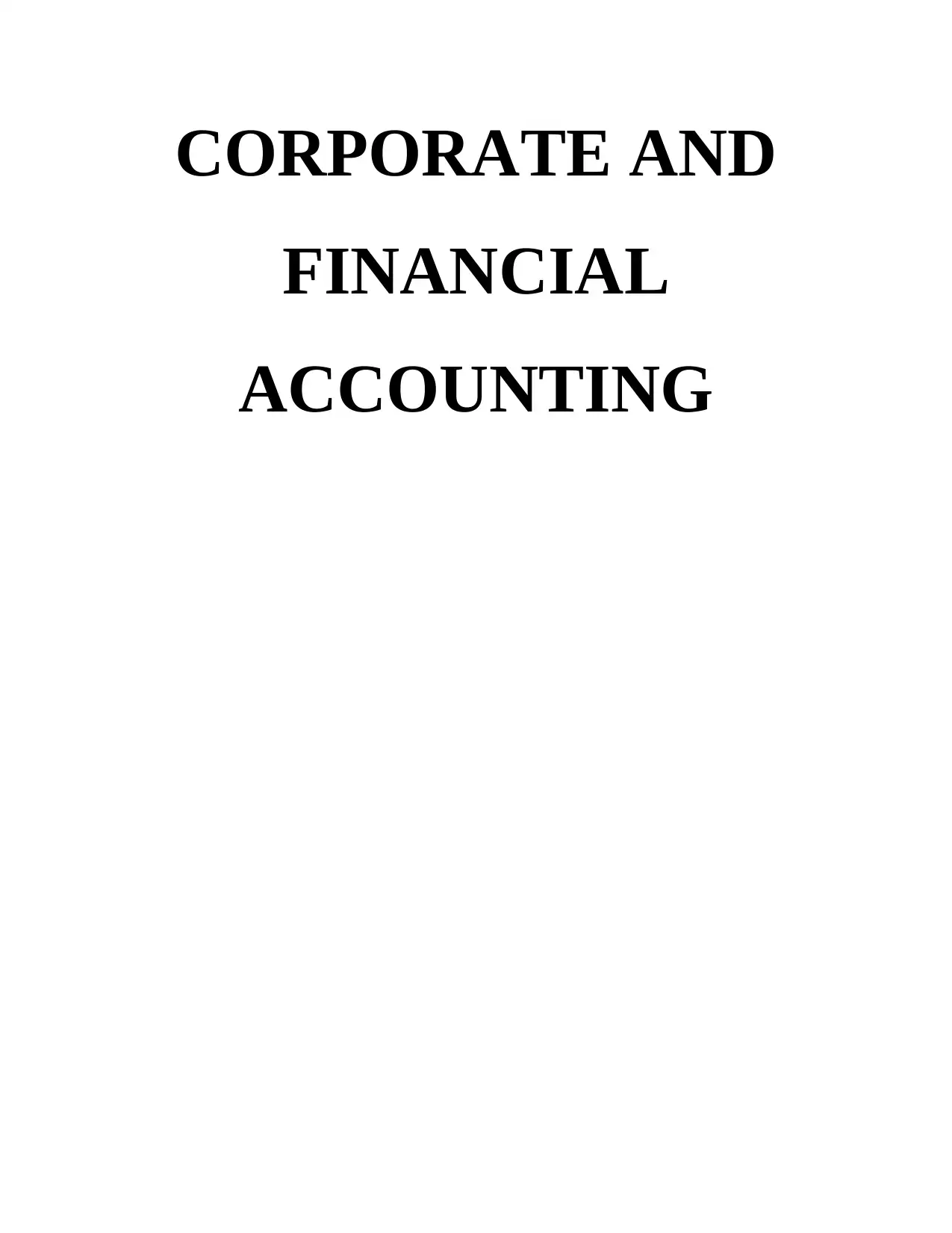
CORPORATE AND
FINANCIAL
ACCOUNTING
FINANCIAL
ACCOUNTING
Paraphrase This Document
Need a fresh take? Get an instant paraphrase of this document with our AI Paraphraser
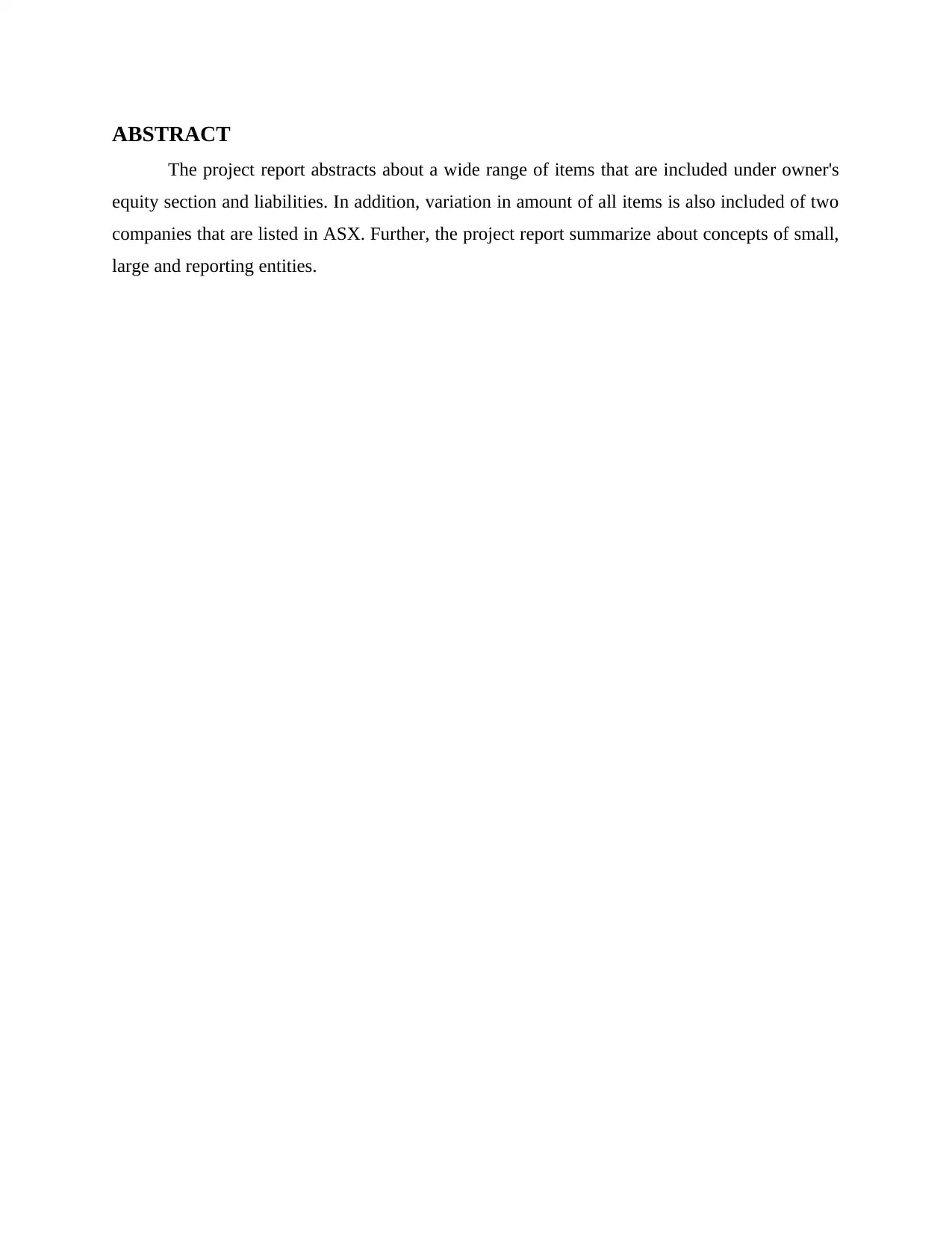
ABSTRACT
The project report abstracts about a wide range of items that are included under owner's
equity section and liabilities. In addition, variation in amount of all items is also included of two
companies that are listed in ASX. Further, the project report summarize about concepts of small,
large and reporting entities.
The project report abstracts about a wide range of items that are included under owner's
equity section and liabilities. In addition, variation in amount of all items is also included of two
companies that are listed in ASX. Further, the project report summarize about concepts of small,
large and reporting entities.

Table of Contents
ABSTRACT.....................................................................................................................................2
INTRODUCTION...........................................................................................................................4
MAIN BODY...................................................................................................................................4
Part (a)........................................................................................................................................4
(I) Items which are recorded in the owner's equity section of both companies..........................4
(ii) Explanation of the movement in each item recorded under the owner equity section.........5
(iii) Explanation of items that are recorded under liabilities section..........................................6
(iv) Explanation of the movement in each item recorded under liabilities section.....................7
(v) Advantages and disadvantages of sources of funds used by both the companies.................9
Part (b).......................................................................................................................................10
Critical examination of the concept of small, large proprietary company and reporting entity
...................................................................................................................................................10
CONCLUSION..............................................................................................................................11
REFERENCES..............................................................................................................................12
ABSTRACT.....................................................................................................................................2
INTRODUCTION...........................................................................................................................4
MAIN BODY...................................................................................................................................4
Part (a)........................................................................................................................................4
(I) Items which are recorded in the owner's equity section of both companies..........................4
(ii) Explanation of the movement in each item recorded under the owner equity section.........5
(iii) Explanation of items that are recorded under liabilities section..........................................6
(iv) Explanation of the movement in each item recorded under liabilities section.....................7
(v) Advantages and disadvantages of sources of funds used by both the companies.................9
Part (b).......................................................................................................................................10
Critical examination of the concept of small, large proprietary company and reporting entity
...................................................................................................................................................10
CONCLUSION..............................................................................................................................11
REFERENCES..............................................................................................................................12
⊘ This is a preview!⊘
Do you want full access?
Subscribe today to unlock all pages.

Trusted by 1+ million students worldwide
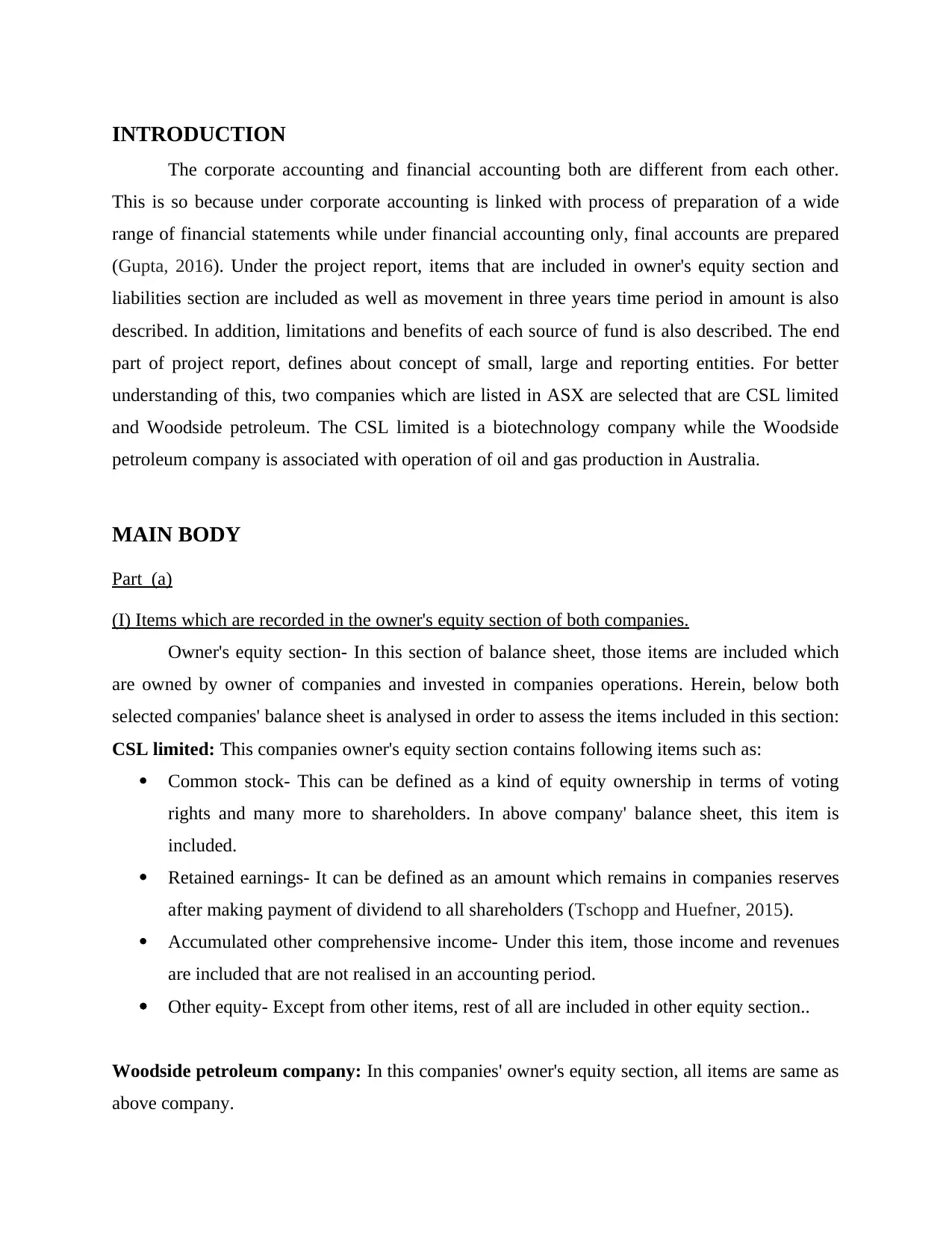
INTRODUCTION
The corporate accounting and financial accounting both are different from each other.
This is so because under corporate accounting is linked with process of preparation of a wide
range of financial statements while under financial accounting only, final accounts are prepared
(Gupta, 2016). Under the project report, items that are included in owner's equity section and
liabilities section are included as well as movement in three years time period in amount is also
described. In addition, limitations and benefits of each source of fund is also described. The end
part of project report, defines about concept of small, large and reporting entities. For better
understanding of this, two companies which are listed in ASX are selected that are CSL limited
and Woodside petroleum. The CSL limited is a biotechnology company while the Woodside
petroleum company is associated with operation of oil and gas production in Australia.
MAIN BODY
Part (a)
(I) Items which are recorded in the owner's equity section of both companies.
Owner's equity section- In this section of balance sheet, those items are included which
are owned by owner of companies and invested in companies operations. Herein, below both
selected companies' balance sheet is analysed in order to assess the items included in this section:
CSL limited: This companies owner's equity section contains following items such as:
Common stock- This can be defined as a kind of equity ownership in terms of voting
rights and many more to shareholders. In above company' balance sheet, this item is
included.
Retained earnings- It can be defined as an amount which remains in companies reserves
after making payment of dividend to all shareholders (Tschopp and Huefner, 2015).
Accumulated other comprehensive income- Under this item, those income and revenues
are included that are not realised in an accounting period.
Other equity- Except from other items, rest of all are included in other equity section..
Woodside petroleum company: In this companies' owner's equity section, all items are same as
above company.
The corporate accounting and financial accounting both are different from each other.
This is so because under corporate accounting is linked with process of preparation of a wide
range of financial statements while under financial accounting only, final accounts are prepared
(Gupta, 2016). Under the project report, items that are included in owner's equity section and
liabilities section are included as well as movement in three years time period in amount is also
described. In addition, limitations and benefits of each source of fund is also described. The end
part of project report, defines about concept of small, large and reporting entities. For better
understanding of this, two companies which are listed in ASX are selected that are CSL limited
and Woodside petroleum. The CSL limited is a biotechnology company while the Woodside
petroleum company is associated with operation of oil and gas production in Australia.
MAIN BODY
Part (a)
(I) Items which are recorded in the owner's equity section of both companies.
Owner's equity section- In this section of balance sheet, those items are included which
are owned by owner of companies and invested in companies operations. Herein, below both
selected companies' balance sheet is analysed in order to assess the items included in this section:
CSL limited: This companies owner's equity section contains following items such as:
Common stock- This can be defined as a kind of equity ownership in terms of voting
rights and many more to shareholders. In above company' balance sheet, this item is
included.
Retained earnings- It can be defined as an amount which remains in companies reserves
after making payment of dividend to all shareholders (Tschopp and Huefner, 2015).
Accumulated other comprehensive income- Under this item, those income and revenues
are included that are not realised in an accounting period.
Other equity- Except from other items, rest of all are included in other equity section..
Woodside petroleum company: In this companies' owner's equity section, all items are same as
above company.
Paraphrase This Document
Need a fresh take? Get an instant paraphrase of this document with our AI Paraphraser
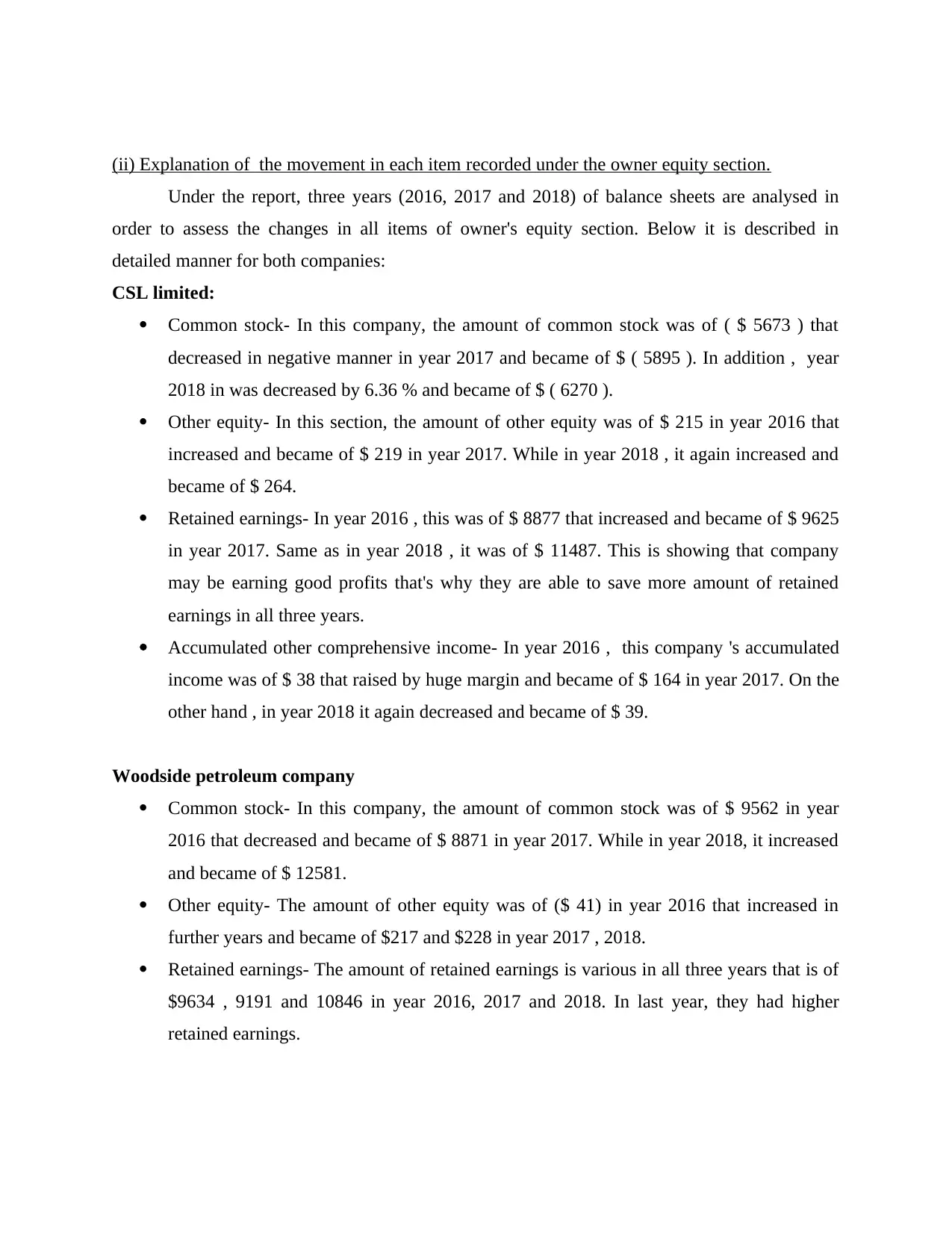
(ii) Explanation of the movement in each item recorded under the owner equity section.
Under the report, three years (2016, 2017 and 2018) of balance sheets are analysed in
order to assess the changes in all items of owner's equity section. Below it is described in
detailed manner for both companies:
CSL limited:
Common stock- In this company, the amount of common stock was of ( $ 5673 ) that
decreased in negative manner in year 2017 and became of $ ( 5895 ). In addition , year
2018 in was decreased by 6.36 % and became of $ ( 6270 ).
Other equity- In this section, the amount of other equity was of $ 215 in year 2016 that
increased and became of $ 219 in year 2017. While in year 2018 , it again increased and
became of $ 264.
Retained earnings- In year 2016 , this was of $ 8877 that increased and became of $ 9625
in year 2017. Same as in year 2018 , it was of $ 11487. This is showing that company
may be earning good profits that's why they are able to save more amount of retained
earnings in all three years.
Accumulated other comprehensive income- In year 2016 , this company 's accumulated
income was of $ 38 that raised by huge margin and became of $ 164 in year 2017. On the
other hand , in year 2018 it again decreased and became of $ 39.
Woodside petroleum company
Common stock- In this company, the amount of common stock was of $ 9562 in year
2016 that decreased and became of $ 8871 in year 2017. While in year 2018, it increased
and became of $ 12581.
Other equity- The amount of other equity was of ($ 41) in year 2016 that increased in
further years and became of $217 and $228 in year 2017 , 2018.
Retained earnings- The amount of retained earnings is various in all three years that is of
$9634 , 9191 and 10846 in year 2016, 2017 and 2018. In last year, they had higher
retained earnings.
Under the report, three years (2016, 2017 and 2018) of balance sheets are analysed in
order to assess the changes in all items of owner's equity section. Below it is described in
detailed manner for both companies:
CSL limited:
Common stock- In this company, the amount of common stock was of ( $ 5673 ) that
decreased in negative manner in year 2017 and became of $ ( 5895 ). In addition , year
2018 in was decreased by 6.36 % and became of $ ( 6270 ).
Other equity- In this section, the amount of other equity was of $ 215 in year 2016 that
increased and became of $ 219 in year 2017. While in year 2018 , it again increased and
became of $ 264.
Retained earnings- In year 2016 , this was of $ 8877 that increased and became of $ 9625
in year 2017. Same as in year 2018 , it was of $ 11487. This is showing that company
may be earning good profits that's why they are able to save more amount of retained
earnings in all three years.
Accumulated other comprehensive income- In year 2016 , this company 's accumulated
income was of $ 38 that raised by huge margin and became of $ 164 in year 2017. On the
other hand , in year 2018 it again decreased and became of $ 39.
Woodside petroleum company
Common stock- In this company, the amount of common stock was of $ 9562 in year
2016 that decreased and became of $ 8871 in year 2017. While in year 2018, it increased
and became of $ 12581.
Other equity- The amount of other equity was of ($ 41) in year 2016 that increased in
further years and became of $217 and $228 in year 2017 , 2018.
Retained earnings- The amount of retained earnings is various in all three years that is of
$9634 , 9191 and 10846 in year 2016, 2017 and 2018. In last year, they had higher
retained earnings.
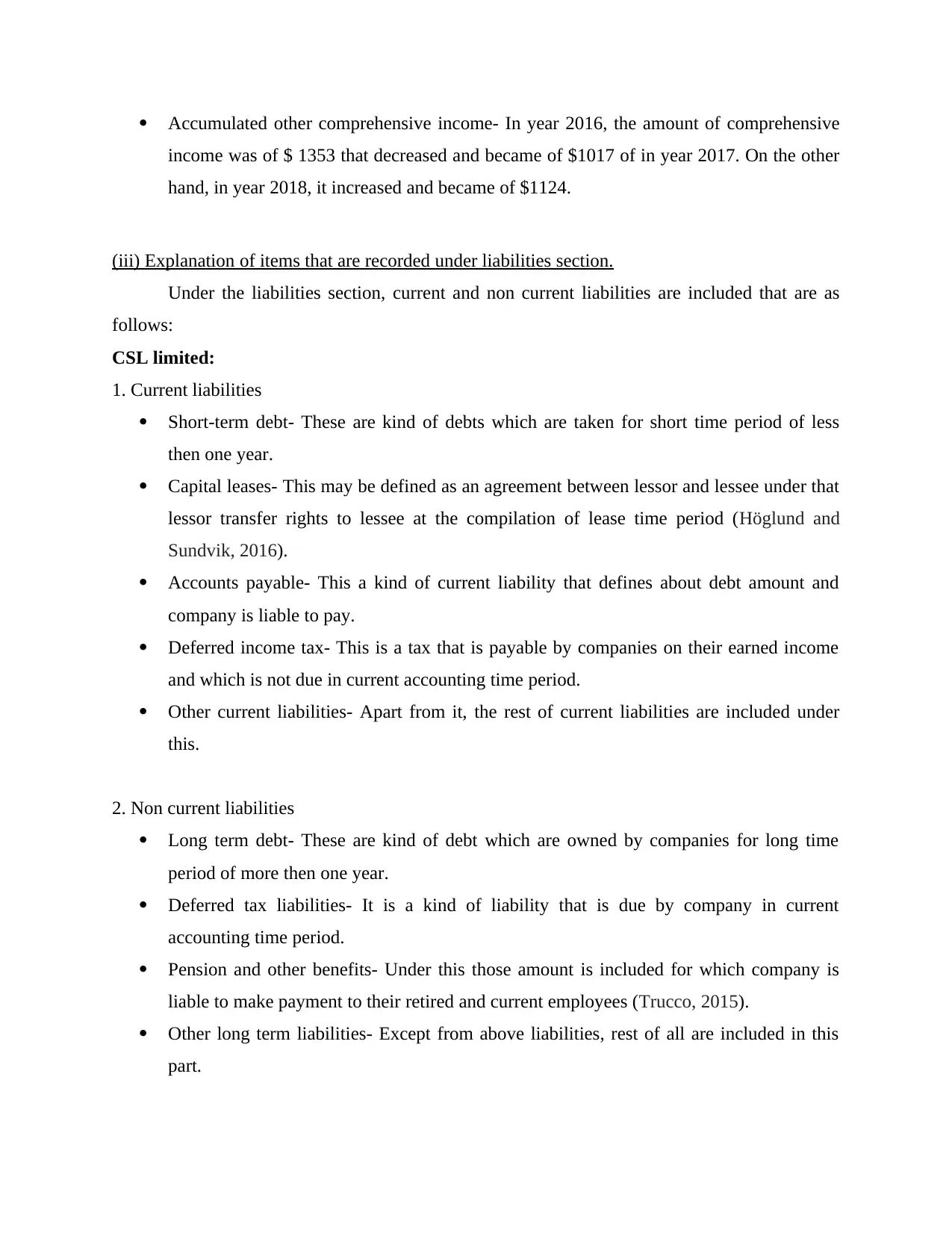
Accumulated other comprehensive income- In year 2016, the amount of comprehensive
income was of $ 1353 that decreased and became of $1017 of in year 2017. On the other
hand, in year 2018, it increased and became of $1124.
(iii) Explanation of items that are recorded under liabilities section.
Under the liabilities section, current and non current liabilities are included that are as
follows:
CSL limited:
1. Current liabilities
Short-term debt- These are kind of debts which are taken for short time period of less
then one year.
Capital leases- This may be defined as an agreement between lessor and lessee under that
lessor transfer rights to lessee at the compilation of lease time period (Höglund and
Sundvik, 2016).
Accounts payable- This a kind of current liability that defines about debt amount and
company is liable to pay.
Deferred income tax- This is a tax that is payable by companies on their earned income
and which is not due in current accounting time period.
Other current liabilities- Apart from it, the rest of current liabilities are included under
this.
2. Non current liabilities
Long term debt- These are kind of debt which are owned by companies for long time
period of more then one year.
Deferred tax liabilities- It is a kind of liability that is due by company in current
accounting time period.
Pension and other benefits- Under this those amount is included for which company is
liable to make payment to their retired and current employees (Trucco, 2015).
Other long term liabilities- Except from above liabilities, rest of all are included in this
part.
income was of $ 1353 that decreased and became of $1017 of in year 2017. On the other
hand, in year 2018, it increased and became of $1124.
(iii) Explanation of items that are recorded under liabilities section.
Under the liabilities section, current and non current liabilities are included that are as
follows:
CSL limited:
1. Current liabilities
Short-term debt- These are kind of debts which are taken for short time period of less
then one year.
Capital leases- This may be defined as an agreement between lessor and lessee under that
lessor transfer rights to lessee at the compilation of lease time period (Höglund and
Sundvik, 2016).
Accounts payable- This a kind of current liability that defines about debt amount and
company is liable to pay.
Deferred income tax- This is a tax that is payable by companies on their earned income
and which is not due in current accounting time period.
Other current liabilities- Apart from it, the rest of current liabilities are included under
this.
2. Non current liabilities
Long term debt- These are kind of debt which are owned by companies for long time
period of more then one year.
Deferred tax liabilities- It is a kind of liability that is due by company in current
accounting time period.
Pension and other benefits- Under this those amount is included for which company is
liable to make payment to their retired and current employees (Trucco, 2015).
Other long term liabilities- Except from above liabilities, rest of all are included in this
part.
⊘ This is a preview!⊘
Do you want full access?
Subscribe today to unlock all pages.

Trusted by 1+ million students worldwide

Woodside petroleum company: In this companies' liabilities section, most of the items are
similar and which are not same are mentioned below:
1. Current liabilities
Deferred revenues- It can be defined as those amount which is received in advanced for
those products that are not delivered.
2. Non current liabilities
Minority interest- This can be defined as those shares that are not owned by parent entity.
(iv) Explanation of the movement in each item recorded under liabilities section.
CSL limited:
1. Current liabilities
Short-term debt- In year 2016, it was of $ 81 that raised in next two years and became of
$155 and 201 in 2017 and 2018.
Capital leases- Its amount is similar in year 2017 and 2018 of $ 4. While in year 2016, it
was of $3.
Accounts payable- The amount of this current liabilities is raising in all three years that is
as : $409 , 519 and 565 in year 2016, 2017 and 2018.
Deferred income tax- The company had deferred tax of $279 in year 2016 which
decreased and became of $263 in 2017. On the other side, it increased in 2018 and
became of $336.
Other current liabilities- Its amount is raising year by year such as: $1079, 1162 and 1384
in all year 2016, 2017 and 2018.
2. Non current liabilities
Long term debt- In year 2016, it was of $4119 that raised in year 2017 and became of
$4980. As well as in year 2018, it was of $5602.
Capital leases- Its amount is decreasing in all three years that is as : $30 , 29 and 28 for
year 2016, 2017 and 2018.
Deferred tax liabilities- The amount of tax liabilities is increasing in all years that is of
$161, 180 and 262 for year 2016, 2017 and 2018.
similar and which are not same are mentioned below:
1. Current liabilities
Deferred revenues- It can be defined as those amount which is received in advanced for
those products that are not delivered.
2. Non current liabilities
Minority interest- This can be defined as those shares that are not owned by parent entity.
(iv) Explanation of the movement in each item recorded under liabilities section.
CSL limited:
1. Current liabilities
Short-term debt- In year 2016, it was of $ 81 that raised in next two years and became of
$155 and 201 in 2017 and 2018.
Capital leases- Its amount is similar in year 2017 and 2018 of $ 4. While in year 2016, it
was of $3.
Accounts payable- The amount of this current liabilities is raising in all three years that is
as : $409 , 519 and 565 in year 2016, 2017 and 2018.
Deferred income tax- The company had deferred tax of $279 in year 2016 which
decreased and became of $263 in 2017. On the other side, it increased in 2018 and
became of $336.
Other current liabilities- Its amount is raising year by year such as: $1079, 1162 and 1384
in all year 2016, 2017 and 2018.
2. Non current liabilities
Long term debt- In year 2016, it was of $4119 that raised in year 2017 and became of
$4980. As well as in year 2018, it was of $5602.
Capital leases- Its amount is decreasing in all three years that is as : $30 , 29 and 28 for
year 2016, 2017 and 2018.
Deferred tax liabilities- The amount of tax liabilities is increasing in all years that is of
$161, 180 and 262 for year 2016, 2017 and 2018.
Paraphrase This Document
Need a fresh take? Get an instant paraphrase of this document with our AI Paraphraser

Pension and other benefits- Its amount is decreasing such as in year 2016, it was of 440
that reduced in 2017 and became of $374 and 353 in 2018.
Other long term liabilities-This is variable in all three years that is of $127, 81 and 223 in
year 2016, 2017 and 2018.
Woodside petroleum company:
1. Current liabilities
Short-term debt- In year 2016, it was of $ 105 that decreased & increased in next two
years and became of $97 and 180 in 2017 and 2018.
Accounts payable- The amount of this current liabilities is raising and decreasing in all
three years that is as : $272, 304 and 300 in year 2016, 2017 and 2018.
Deferred income tax- The company had deferred tax of $105 in year 2016 which
decreased and became of $78 in 2017. On the other side, it increased in 2018 and became
of $105.
Other current liabilities- Its amount is raising and decreasing year by year such as: $828,
915 and 895 in all year 2016, 2017 and 2018.
2. Non current liabilities
Long term debt- In year 2016, it was of $6768 that decreased in year 2017 and became of
$6396. As well as in year 2018, it was of $5684.
Minority interest- Its amount is decreasing in all three years that is as : 1137, 1064 and
1180 for year 2016, 2017 and 2018.
Deferred tax liabilities- The amount of tax liabilities is increasing in all years that is of
$2181, 2305 and 2922 for year 2016, 2017 and 2018.
Pension and other benefits- Its amount is decreasing such as in year 2016, it was of 40
that reduced in 2017 and became of $37 and 34 in 2018.
Other long term liabilities-This is variable in all three years that is of $2244, 2073 and
2300 in year 2016, 2017 and 2018.
(v) Advantages and disadvantages of sources of funds used by both the companies.
Sources of funds in CSL Limited:
that reduced in 2017 and became of $374 and 353 in 2018.
Other long term liabilities-This is variable in all three years that is of $127, 81 and 223 in
year 2016, 2017 and 2018.
Woodside petroleum company:
1. Current liabilities
Short-term debt- In year 2016, it was of $ 105 that decreased & increased in next two
years and became of $97 and 180 in 2017 and 2018.
Accounts payable- The amount of this current liabilities is raising and decreasing in all
three years that is as : $272, 304 and 300 in year 2016, 2017 and 2018.
Deferred income tax- The company had deferred tax of $105 in year 2016 which
decreased and became of $78 in 2017. On the other side, it increased in 2018 and became
of $105.
Other current liabilities- Its amount is raising and decreasing year by year such as: $828,
915 and 895 in all year 2016, 2017 and 2018.
2. Non current liabilities
Long term debt- In year 2016, it was of $6768 that decreased in year 2017 and became of
$6396. As well as in year 2018, it was of $5684.
Minority interest- Its amount is decreasing in all three years that is as : 1137, 1064 and
1180 for year 2016, 2017 and 2018.
Deferred tax liabilities- The amount of tax liabilities is increasing in all years that is of
$2181, 2305 and 2922 for year 2016, 2017 and 2018.
Pension and other benefits- Its amount is decreasing such as in year 2016, it was of 40
that reduced in 2017 and became of $37 and 34 in 2018.
Other long term liabilities-This is variable in all three years that is of $2244, 2073 and
2300 in year 2016, 2017 and 2018.
(v) Advantages and disadvantages of sources of funds used by both the companies.
Sources of funds in CSL Limited:
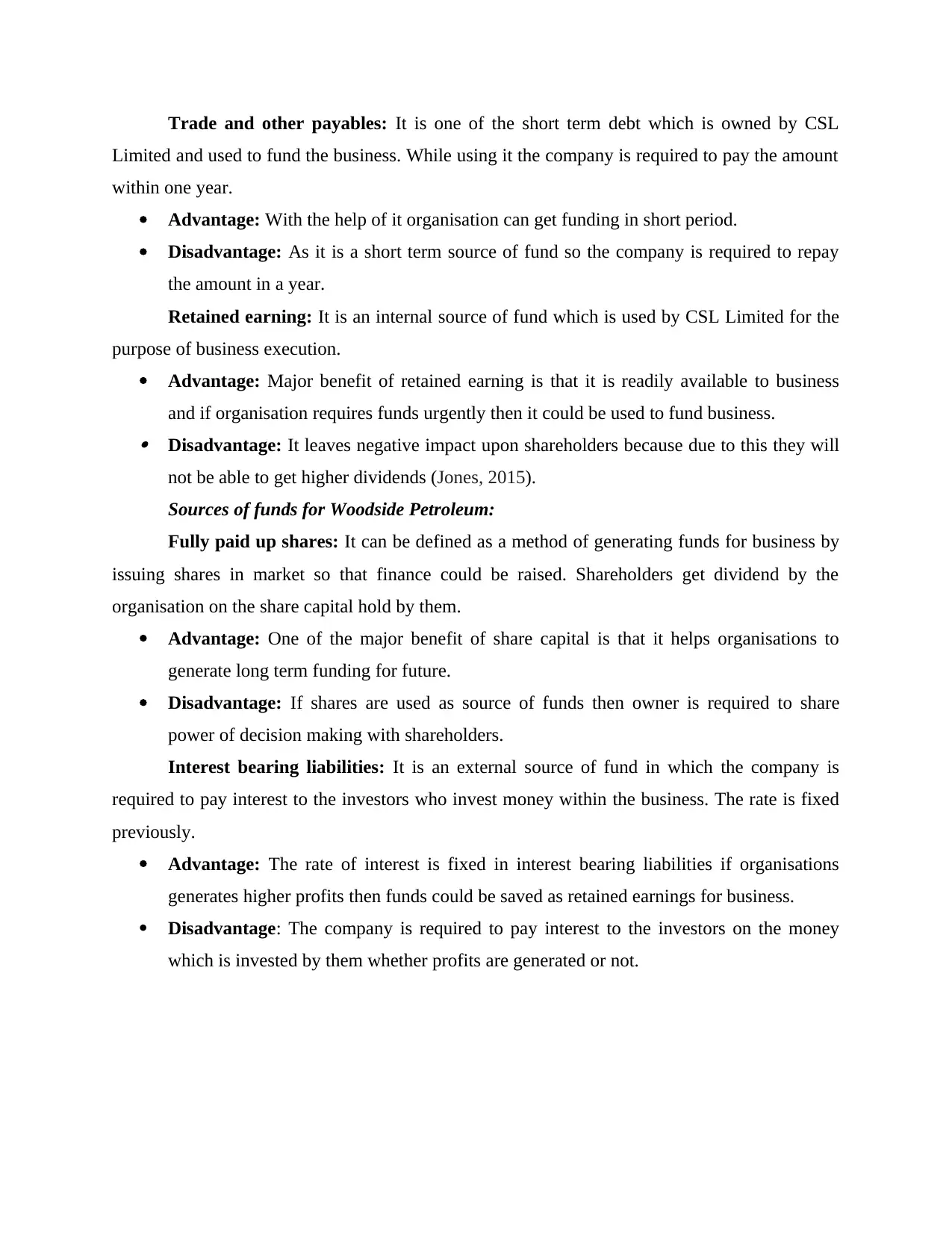
Trade and other payables: It is one of the short term debt which is owned by CSL
Limited and used to fund the business. While using it the company is required to pay the amount
within one year.
Advantage: With the help of it organisation can get funding in short period.
Disadvantage: As it is a short term source of fund so the company is required to repay
the amount in a year.
Retained earning: It is an internal source of fund which is used by CSL Limited for the
purpose of business execution.
Advantage: Major benefit of retained earning is that it is readily available to business
and if organisation requires funds urgently then it could be used to fund business. Disadvantage: It leaves negative impact upon shareholders because due to this they will
not be able to get higher dividends (Jones, 2015).
Sources of funds for Woodside Petroleum:
Fully paid up shares: It can be defined as a method of generating funds for business by
issuing shares in market so that finance could be raised. Shareholders get dividend by the
organisation on the share capital hold by them.
Advantage: One of the major benefit of share capital is that it helps organisations to
generate long term funding for future.
Disadvantage: If shares are used as source of funds then owner is required to share
power of decision making with shareholders.
Interest bearing liabilities: It is an external source of fund in which the company is
required to pay interest to the investors who invest money within the business. The rate is fixed
previously.
Advantage: The rate of interest is fixed in interest bearing liabilities if organisations
generates higher profits then funds could be saved as retained earnings for business.
Disadvantage: The company is required to pay interest to the investors on the money
which is invested by them whether profits are generated or not.
Limited and used to fund the business. While using it the company is required to pay the amount
within one year.
Advantage: With the help of it organisation can get funding in short period.
Disadvantage: As it is a short term source of fund so the company is required to repay
the amount in a year.
Retained earning: It is an internal source of fund which is used by CSL Limited for the
purpose of business execution.
Advantage: Major benefit of retained earning is that it is readily available to business
and if organisation requires funds urgently then it could be used to fund business. Disadvantage: It leaves negative impact upon shareholders because due to this they will
not be able to get higher dividends (Jones, 2015).
Sources of funds for Woodside Petroleum:
Fully paid up shares: It can be defined as a method of generating funds for business by
issuing shares in market so that finance could be raised. Shareholders get dividend by the
organisation on the share capital hold by them.
Advantage: One of the major benefit of share capital is that it helps organisations to
generate long term funding for future.
Disadvantage: If shares are used as source of funds then owner is required to share
power of decision making with shareholders.
Interest bearing liabilities: It is an external source of fund in which the company is
required to pay interest to the investors who invest money within the business. The rate is fixed
previously.
Advantage: The rate of interest is fixed in interest bearing liabilities if organisations
generates higher profits then funds could be saved as retained earnings for business.
Disadvantage: The company is required to pay interest to the investors on the money
which is invested by them whether profits are generated or not.
⊘ This is a preview!⊘
Do you want full access?
Subscribe today to unlock all pages.

Trusted by 1+ million students worldwide
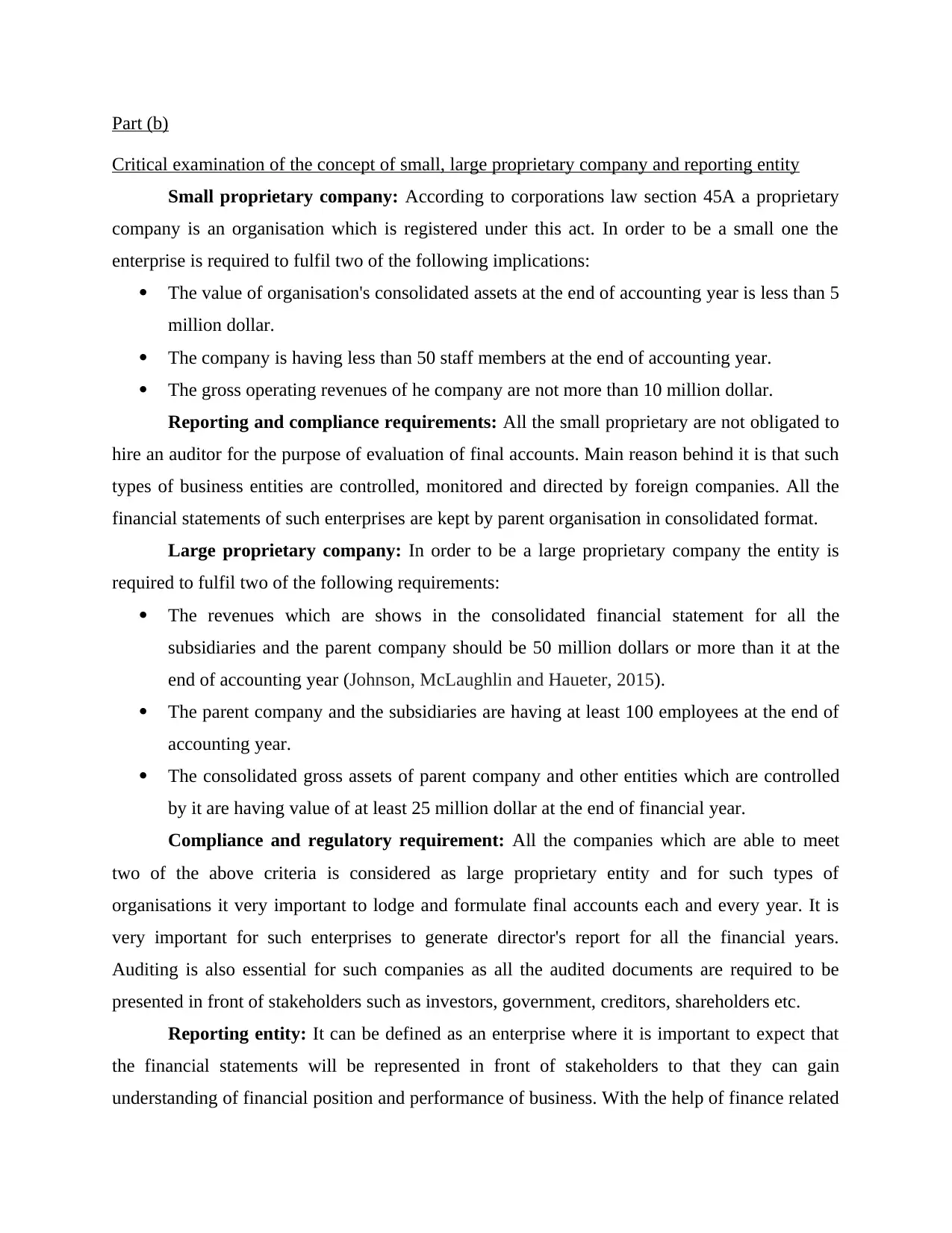
Part (b)
Critical examination of the concept of small, large proprietary company and reporting entity
Small proprietary company: According to corporations law section 45A a proprietary
company is an organisation which is registered under this act. In order to be a small one the
enterprise is required to fulfil two of the following implications:
The value of organisation's consolidated assets at the end of accounting year is less than 5
million dollar.
The company is having less than 50 staff members at the end of accounting year.
The gross operating revenues of he company are not more than 10 million dollar.
Reporting and compliance requirements: All the small proprietary are not obligated to
hire an auditor for the purpose of evaluation of final accounts. Main reason behind it is that such
types of business entities are controlled, monitored and directed by foreign companies. All the
financial statements of such enterprises are kept by parent organisation in consolidated format.
Large proprietary company: In order to be a large proprietary company the entity is
required to fulfil two of the following requirements:
The revenues which are shows in the consolidated financial statement for all the
subsidiaries and the parent company should be 50 million dollars or more than it at the
end of accounting year (Johnson, McLaughlin and Haueter, 2015).
The parent company and the subsidiaries are having at least 100 employees at the end of
accounting year.
The consolidated gross assets of parent company and other entities which are controlled
by it are having value of at least 25 million dollar at the end of financial year.
Compliance and regulatory requirement: All the companies which are able to meet
two of the above criteria is considered as large proprietary entity and for such types of
organisations it very important to lodge and formulate final accounts each and every year. It is
very important for such enterprises to generate director's report for all the financial years.
Auditing is also essential for such companies as all the audited documents are required to be
presented in front of stakeholders such as investors, government, creditors, shareholders etc.
Reporting entity: It can be defined as an enterprise where it is important to expect that
the financial statements will be represented in front of stakeholders to that they can gain
understanding of financial position and performance of business. With the help of finance related
Critical examination of the concept of small, large proprietary company and reporting entity
Small proprietary company: According to corporations law section 45A a proprietary
company is an organisation which is registered under this act. In order to be a small one the
enterprise is required to fulfil two of the following implications:
The value of organisation's consolidated assets at the end of accounting year is less than 5
million dollar.
The company is having less than 50 staff members at the end of accounting year.
The gross operating revenues of he company are not more than 10 million dollar.
Reporting and compliance requirements: All the small proprietary are not obligated to
hire an auditor for the purpose of evaluation of final accounts. Main reason behind it is that such
types of business entities are controlled, monitored and directed by foreign companies. All the
financial statements of such enterprises are kept by parent organisation in consolidated format.
Large proprietary company: In order to be a large proprietary company the entity is
required to fulfil two of the following requirements:
The revenues which are shows in the consolidated financial statement for all the
subsidiaries and the parent company should be 50 million dollars or more than it at the
end of accounting year (Johnson, McLaughlin and Haueter, 2015).
The parent company and the subsidiaries are having at least 100 employees at the end of
accounting year.
The consolidated gross assets of parent company and other entities which are controlled
by it are having value of at least 25 million dollar at the end of financial year.
Compliance and regulatory requirement: All the companies which are able to meet
two of the above criteria is considered as large proprietary entity and for such types of
organisations it very important to lodge and formulate final accounts each and every year. It is
very important for such enterprises to generate director's report for all the financial years.
Auditing is also essential for such companies as all the audited documents are required to be
presented in front of stakeholders such as investors, government, creditors, shareholders etc.
Reporting entity: It can be defined as an enterprise where it is important to expect that
the financial statements will be represented in front of stakeholders to that they can gain
understanding of financial position and performance of business. With the help of finance related
Paraphrase This Document
Need a fresh take? Get an instant paraphrase of this document with our AI Paraphraser
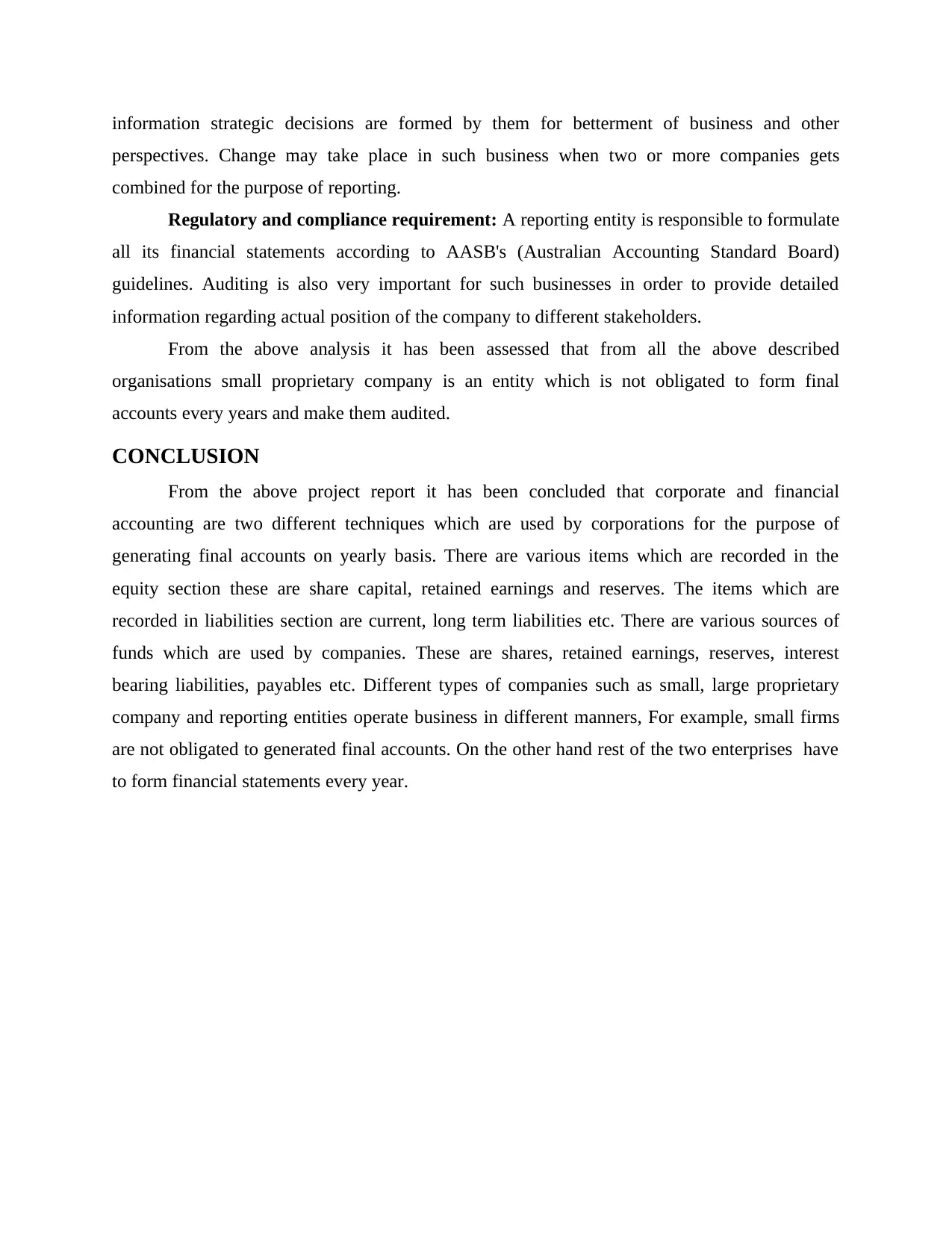
information strategic decisions are formed by them for betterment of business and other
perspectives. Change may take place in such business when two or more companies gets
combined for the purpose of reporting.
Regulatory and compliance requirement: A reporting entity is responsible to formulate
all its financial statements according to AASB's (Australian Accounting Standard Board)
guidelines. Auditing is also very important for such businesses in order to provide detailed
information regarding actual position of the company to different stakeholders.
From the above analysis it has been assessed that from all the above described
organisations small proprietary company is an entity which is not obligated to form final
accounts every years and make them audited.
CONCLUSION
From the above project report it has been concluded that corporate and financial
accounting are two different techniques which are used by corporations for the purpose of
generating final accounts on yearly basis. There are various items which are recorded in the
equity section these are share capital, retained earnings and reserves. The items which are
recorded in liabilities section are current, long term liabilities etc. There are various sources of
funds which are used by companies. These are shares, retained earnings, reserves, interest
bearing liabilities, payables etc. Different types of companies such as small, large proprietary
company and reporting entities operate business in different manners, For example, small firms
are not obligated to generated final accounts. On the other hand rest of the two enterprises have
to form financial statements every year.
perspectives. Change may take place in such business when two or more companies gets
combined for the purpose of reporting.
Regulatory and compliance requirement: A reporting entity is responsible to formulate
all its financial statements according to AASB's (Australian Accounting Standard Board)
guidelines. Auditing is also very important for such businesses in order to provide detailed
information regarding actual position of the company to different stakeholders.
From the above analysis it has been assessed that from all the above described
organisations small proprietary company is an entity which is not obligated to form final
accounts every years and make them audited.
CONCLUSION
From the above project report it has been concluded that corporate and financial
accounting are two different techniques which are used by corporations for the purpose of
generating final accounts on yearly basis. There are various items which are recorded in the
equity section these are share capital, retained earnings and reserves. The items which are
recorded in liabilities section are current, long term liabilities etc. There are various sources of
funds which are used by companies. These are shares, retained earnings, reserves, interest
bearing liabilities, payables etc. Different types of companies such as small, large proprietary
company and reporting entities operate business in different manners, For example, small firms
are not obligated to generated final accounts. On the other hand rest of the two enterprises have
to form financial statements every year.
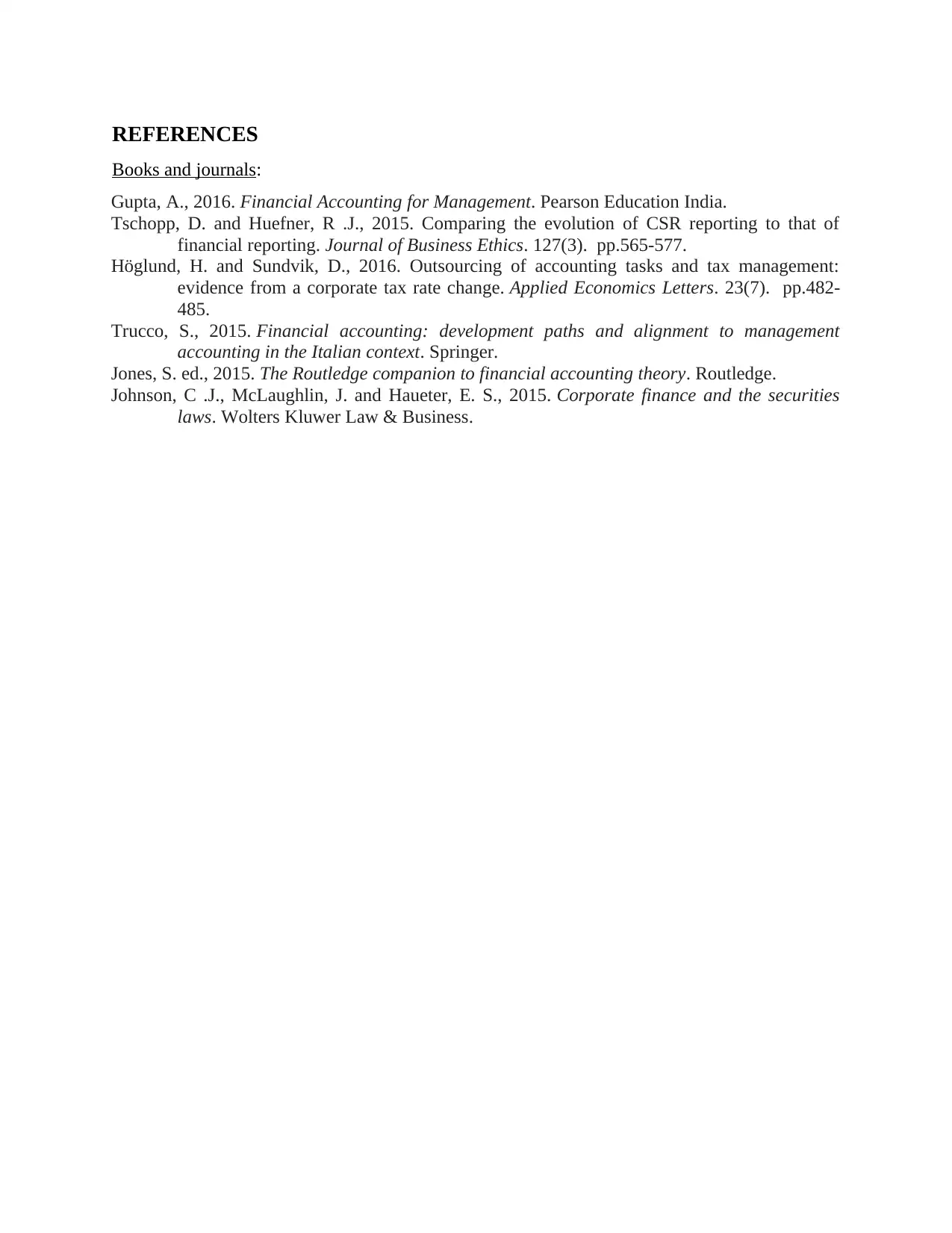
REFERENCES
Books and journals:
Gupta, A., 2016. Financial Accounting for Management. Pearson Education India.
Tschopp, D. and Huefner, R .J., 2015. Comparing the evolution of CSR reporting to that of
financial reporting. Journal of Business Ethics. 127(3). pp.565-577.
Höglund, H. and Sundvik, D., 2016. Outsourcing of accounting tasks and tax management:
evidence from a corporate tax rate change. Applied Economics Letters. 23(7). pp.482-
485.
Trucco, S., 2015. Financial accounting: development paths and alignment to management
accounting in the Italian context. Springer.
Jones, S. ed., 2015. The Routledge companion to financial accounting theory. Routledge.
Johnson, C .J., McLaughlin, J. and Haueter, E. S., 2015. Corporate finance and the securities
laws. Wolters Kluwer Law & Business.
Books and journals:
Gupta, A., 2016. Financial Accounting for Management. Pearson Education India.
Tschopp, D. and Huefner, R .J., 2015. Comparing the evolution of CSR reporting to that of
financial reporting. Journal of Business Ethics. 127(3). pp.565-577.
Höglund, H. and Sundvik, D., 2016. Outsourcing of accounting tasks and tax management:
evidence from a corporate tax rate change. Applied Economics Letters. 23(7). pp.482-
485.
Trucco, S., 2015. Financial accounting: development paths and alignment to management
accounting in the Italian context. Springer.
Jones, S. ed., 2015. The Routledge companion to financial accounting theory. Routledge.
Johnson, C .J., McLaughlin, J. and Haueter, E. S., 2015. Corporate finance and the securities
laws. Wolters Kluwer Law & Business.
⊘ This is a preview!⊘
Do you want full access?
Subscribe today to unlock all pages.

Trusted by 1+ million students worldwide
1 out of 13
Related Documents
Your All-in-One AI-Powered Toolkit for Academic Success.
+13062052269
info@desklib.com
Available 24*7 on WhatsApp / Email
![[object Object]](/_next/static/media/star-bottom.7253800d.svg)
Unlock your academic potential
Copyright © 2020–2025 A2Z Services. All Rights Reserved. Developed and managed by ZUCOL.





